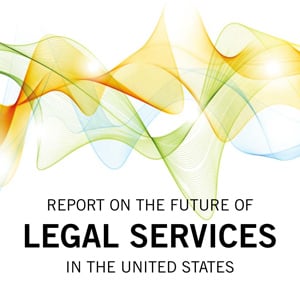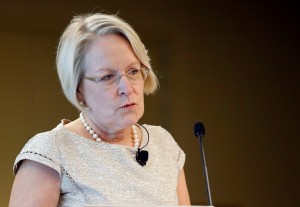Can the access-to-justice gap be closed? These recommendations might make it possible

The ABA Commission on the Future of Legal Services’ report is available here (PDF).
As expected, the ABA Commission on the Future of Legal Services delivered plenty of recommendations for how the bar can close the access to justice gap in America, while steering clear of the most contentious issue: whether alternative business structures—most notably nonlawyer ownership of law firms—should be permissible.
After two years of work, the commission released its final report (PDF) on Saturday during the 2016 ABA Annual Meeting in San Francisco. The underlying message of the report, said ABA President Paulette Brown of Morristown, New Jersey, is that “The future is not going to wait for us. We have got to go with it. We have to not let the future get away from us.”
Citing statistics showing that in some jurisdictions, over 80 percent of the civil legal needs of lower-to-middle income individuals went unmet, the commission called on the legal profession to support the idea that all people should have some form of legal assistance for their civil legal needs. To that end, the commission found that the legal profession “should support the aspirational goal of 100 percent access to effective assistance for essential civil legal needs.”
In order to reach that standard, the report made several recommendations. The commission stated that courts should be open to innovations in the delivery of legal services and called on them to adopt the ABA Model Regulatory Objectives for the Provision of Legal Services (PDF). States should “explore how legal services are delivered by entities that employ new technologies and internet-based platforms and then assess the benefits and risks to the public.” Courts, meanwhile, should provide automated services for pro se individuals, including online dispute resolution and remote-access self-service kiosks.
The report also recommended that the ABA open a Center for Innovation that would amount to a research and development division for the legal industry. “Industries as diverse as consulting, medicine, and personal finance have invested in research and development laboratories to create new service offerings and substantially improve client relationships,” the report stated. “Lawyers must do the same, and the Innovation Center can play an active role in these efforts.”

Andrew Perlman. Photo by Tony Avelar.
The Center on Innovation has been approved by the ABA Board of Governors. Its primary tasks will include assisting law firms interested in introducing new approaches to their practices, studying innovations in legal services delivery in other countries, and developing training programs for law students interested in innovative law practice. The governing council of the center will be chaired by Andrew M. Perlman, the dean at Suffolk University Law School in Boston. He has served as vice chair of the Commission on the Future of Legal Services.
The commission will go out of its existence at the close of the annual meeting, Perlman said, so the center will play a key role in carrying some of the commission’s recommendations forward. At the same time, the commission’s recommendations “are just a snapshot in time,” he said, “but legal services continue to evolve, and new ideas will have to be considered.”
It is crucial that the ABA and other elements of the legal profession help lawyers understand how the legal environment is changing, said commission chair Judy Perry Martinez of New Orleans. “We can help lawyers understand what the public need is,” she said. “If we can help lawyers to be of service to the public, we can be of great service to our members.”

Judy Perry Martinez. Photo by Tony Avelar.
Another area of focus for the commission was the role of legal technology and its role in bridging the access-to-justice gap. The commission recommended that “all members of the legal profession should keep abreast of relevant technologies” and cited the Florida Bar Board of Governors, which recently approved mandatory technology CLE requirements for state lawyers. Additionally, the report stated that the legal profession should partner with other industries to design, develop and create new delivery models and technological tools.
The wide-ranging report also called for criminal justice reform; increased diversity within the legal profession; regular preventive legal checkups for individuals; and utilization of statistics and metrics to determine how effective the intended reforms really are.
“Some may view the commission’s recommendations as too controversial, and others may view the recommendations as insufficiently bold,” the commission said in its report. “What is clear, however, is that the solutions will require the efforts of all stakeholders in order to implement the recommendations contained in this report.”
The report’s publication “marks a real milestone for the ABA and the entire organized bar,” said Linda A. Klein of Atlanta, who will begin her yearlong term as the association’s president at the close of the annual meeting. “It’s neither easy nor comfortable to embrace change, but we’ve got to do it.”
Follow along with our full coverage of the 2016 ABA Annual Meeting.



